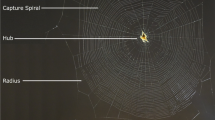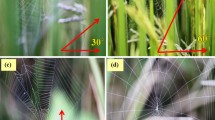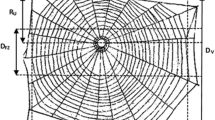Abstract
Shelter and trap-building animals that compete for limited space and/or face costly relocations benefit from being flexible in their construction behavior. Orb spiders are good examples of this and their easily quantifiable two-dimensional webs allow us to analyze the behavioral adaptations and costs in terms of higher error levels or less precision resulting from building webs in sub-optimal conditions. Here I study behavioral flexibility in spatially constrained spiders by analyzing a wide range of web parameters including measures that indicate errors during web-building. I compare the geometry of laboratory webs of two orb spiders, Cyclosa caroli and Eustala illicita, built in differently shaped experimental frames and report two major findings. i) The two species differ in their ability to build webs in constrained spaces. ii) E. illicita adjusted a range of parameters including shape, area utilization and mesh height in response to spatial constraints, but kept other parameters constant, most notably the length of anchor threads and the shape of the auxiliary spiral. I furthermore found that constrained spiders did not make significantly more errors during web-building than when they had amble space available.











Similar content being viewed by others
References
Ades C (1986) A construção de teia geométrica como programa comportamental. Ciéncia e Cultura 38:760–775
Agnarsson I, Kuntner M, Blackledge TA (2010) Bioprospecting finds the toughest biological material: extraordinary silk from a giant riverine orb spider. PLoS One 5:e11234
Barrantes G, Eberhard WG (2012) Extreme behavioral adjustments by an orb-web spider to restricted space. Ethology 118:438–449
Breitwisch R, Breitwisch M (1991) House sparrows open an automatic door. Wilson Bull 103:725–726
Chittka L, Niven J (2009) Are bigger brains better? Curr Biol 19:R995–R1008
Craig CL (1989) Alternative foraging modes of orb web weaving spiders. Biotropica 2:257–264
Downing HA (1992) Hole repair and the influence on learning on nest repair in the paper wasp, Polistes fuscatus (Hymenoptera: Vespidae). J Insect Behav 5:459–468
Dukas R, Dukas L (2011) Coping with nonrepairable body damage: effects of wingdamage on foraging performance in bees. Anim Behav 81:635–638
Eberhard WG (1988) Behavioral flexibility in orb web construction: effects of supplies in different silk glands and spider size and weight. J Arachnol 16:295–302
Eberhard WG (2007) Miniaturized orb-weaving spiders: behavioural precision is not limited by small size. Proc Roy Soc Lond B 274:2203–2209
Eberhard WG (2011) Are smaller animals behaviourally limited? Lack of clear constraints in miniature spiders. Anim Behav 81:813–823
Eberhard WG and Hesselberg T (2012) Cues that spiders (Araneae: Araneidae, Tetragnathidae) use to build orbs: lapses in attention to one set of cues due to dissonance with others? Ethology. doi:10.1111/j.1439-0310.2012.02048.x
Foelix RF (1996) Biology of spiders, 2nd edn. Oxford University Press
Hansell M (2000) Bird nests and construction behaviour. Cambridge University Press
Hansell M, Ruxton GD (2008) Setting tool use within the context of animal construction behaviour. Trends Ecol Evol 23:73–78
Harmer AMT, Herberstein ME (2009) Taking it to extremes: what drives extreme web elongation in Australian ladder web spiders (Araneidae: Telaprocera maudae)? Anim Behav 78:499–504
Harmer AMT, Herberstein ME (2010) Functional diversity of ladder-webs: moth specialization or optimal area use? J Arachnol 38:119–122
Herberstein ME, Tso IM (2000) Evaluation of formulae to estimate the capture area of orb webs (Araneoidea, Araneae). J Arachnol 28:180–184
Hesselberg T (2010) Ontogenetic changes in web design in two orb-web spiders. Ethology 116:535–545
Hesselberg T, Triana E (2010) The web of the acacia orb-spider Eustala illicita (Araneae: Araneidae) with notes on its natural history. J Arachnol 38:21–26
Hesselberg T, Vollrath F (2004) The effects of neurotoxins on web-geometry and web-building behaviour in Araneus diadematus Cl. Physiol Behav 82:519–529
Hingston RW (1923) A naturalist in the Himalaya. Small & Maynard, Boston
Jackson RR, Wilcox RS (1993) Observations in nature of detouring behaviour by Portia fimbriata, a web-invading aggressive mimic jumping spider from Queensland. J Zool 230:135–139
Kacelnik A (2009) Tools for thought or thoughts for tools? PNAS 25:10070–10072
Krink T, Vollrath F (1999) A virtual robot to model the use of regenerated legs in a web-building spider. Anim Behav 57:223–232
Krink T, Vollrath F (2000) Optimal area use in orb webs of the spider Araneus diadematus. Naturwissenschaften 87:90–93
Laland KN, Reader SM (1999) Foraging innovation in the guppy. Anim Behav 57:331–340
Liao C-P, Chi K-J, Tso I-M (2009) The effects of wind on trap structural and material properties of a sit-and-wait predator. Behav Ecol 20:1194–1203
Madden JR (2008) Do bowerbirds exhibit cultures? Anim Cogn 11:1–12
Mayer G (1953) Untersuchungen über Herstellung und Struktur des Radnetzes von Aranea diadema und Zilla x-notata mit besondenderer berücksichtigung des Unterschiedes von Jugend- und Altersnetzen. Z Tierpsychol 9:337–362
Nelson XJ and Jackson RR (2011) Flexibility in the foraging strategies of spiders. In: Herberstein ME (ed) Spider Behaviour: flexibility and versatility. Cambridge University Press. Pp. 31–56
Peakall DB (1971) Conservation of web-proteins in the spider, Araneus diadematus. J Exp Zool 176:257–264
Reed CF, Witt PN, Scarboro MB, Peakall DB (1970) Experience and the orb web. Develop Psychobiol 3:251–265
Rice WR (1989) Analyzing tables of statistical tests. Evolution 43:223–225
Seed A, Byrne R (2010) Animal tool-use. Curr Biol 20:R1032–R1039
Sensenig A, Agnarsson I, Gondek TM, Blackledge TA (2010) Webs in vitro and in vivo: spiders alter their orb-web spinning behaviour in the laboratory. J Arachnol 38:183–191
Uetz GW, Johnson AD, Schemske DW (1978) Web placement, web structure and prey capture in orb-weavers. Bull Br Arachnol Soc 4:141–148
Uhl G (2008) Size dependent occurrence of different types of web decorations and a barrier web in the tropical spider Argiope argentata (Fabricius 1775) (Araneae Araneidae). Trop Zool 21:97–108
Vollrath F (1985) Web spider’s dilemma: a risky move or site dependent growth. Oecologia 68:69–72
Vollrath F (1987) Altered geometry of webs in spiders with regenerated legs. Nature 328:247–248
Vollrath F (1988) Spiral orientation of Araneus diadematus orb webs built during vertical rotation. J Comp Physiol A 162:413–419
Vollrath F (1992) Analysis and interpretation of orb spider exploration and web-building behavior. Adv Study Behav 21:147–199
Vollrath F, Selden P (2007) The role of behavior in the evolution of spiders, silks and webs. Ann Rev Ecol Evol Syst 38:819–846
Vollrath F, Downes M, Krackow S (1997) Design variability in web geometry of an orb-weaving spider. Physiol Behav 62:735–743
Williams DD, Penak BL (1980) Some aspects of case building in Phryganea cinera Walker (Trichoptera: Phryganeidae). Anim Behav 28:103–110
Wirth E, Barth FG (1992) Forces in the spider orb web. J Comp Physiol A 171:359–371
Wise D (1993) Spiders in ecological webs. Cambridge University Press, New York
Witt PN (1971) Drugs alter web-building of spiders: a review and evaluation. Behav Sci 16:98–112
Witt PN, Rawlings JO, Reed CF (1972) Ontogeny of web-building behavior in two orb-weaving spiders. Am Zool 12:445–454
Witt PN, Scarboro MB, Daniels R, Peakall DB, Gause RL (1977) Spider web-building in outer space: evaluation of records from the Skylab experiment. J Arachnol 4:115–124
Zar JH (1996) Biostatistical Analysis, 3rd edn. Prentice Hall
Zschokke S, Vollrath F (2000) Planarity and size of orb-webs built by Araneus diadematus (Araneae: Araneidae) under natural and experimental conditions. Ekólogia 19:307–318
Acknowledgements
Thanks to Diomedes Quientero, Roberto Miranda and Nikolaj Scharff for helping to identify the spider species and to William Eberhard and two anonymous reviewers for their helpful comments to a previous version of the manuscript. The author gratefully acknowledges the permission granted by the Parque Natural Metropolitano and the Autoridad Nacional del Ambiente (ANAM permits no. SE/A-81-08 and SE/A-104-08) to carry out this study. The study was funded by a Smithsonian Postdoctoral Fellowship.
Author information
Authors and Affiliations
Corresponding author
Rights and permissions
About this article
Cite this article
Hesselberg, T. Web-Building Flexibility Differs in Two Spatially Constrained Orb Spiders. J Insect Behav 26, 283–303 (2013). https://doi.org/10.1007/s10905-012-9335-7
Revised:
Accepted:
Published:
Issue Date:
DOI: https://doi.org/10.1007/s10905-012-9335-7




